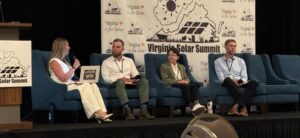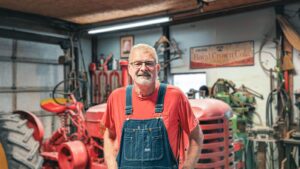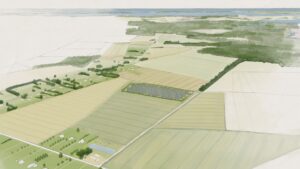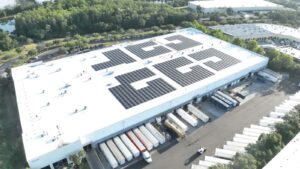Solar farming in Michigan offers a unique solution for preserving agricultural heritage. Meet John Tuckerman, whose family has farmed the same land in Lenawee County, Michigan for seven generations. His story illuminates the complex decisions facing today’s farmers as they balance tradition, progress, and the preservation of agricultural land through innovative solar farming approaches.
Rooted in Seven Generations of Farming
John Tuckerman’s connection to his land runs deeper than most. As a fifth-generation farmer whose family now spans seven generations on the same property, he grows corn, soybeans, and wheat using both conventional and organic methods. John’s story extends far beyond his crops to include community leadership, difficult choices, and the fight to preserve agricultural land in an increasingly developed world through solar farming in Michigan.
“When you work at something your whole life, it becomes more than just a place to live,” John reflects. “This whole farm is home.”
His great-great-grandmother came from Germany in the late 1800s, and the family has been working this land ever since. The continuity carries both sentimental and practical value. “When you’re a farm family, you don’t sell your farm. You do what’s necessary to be able to pass that on to the next generation. Every generation makes a sacrifice to preserve that family farm.”
A Leader’s Perspective on Rural Development
John’s commitment to his community led him to serve twelve years on the Lenawee County Commission, including four years as chair. During his tenure in the 2000s and early 2010s, he championed an ambitious vision: marketing Lenawee County as 25% green energy by 2025.
“We thought if we could market Lenawee County as being green and also promote agriculture, we could keep landowners and farm families financially strong so the land would stay in agriculture,” he explains. The commission successfully built an ethanol plant and promoted renewable energy development, including solar projects.
However, John discovered that newcomers to the area often had different priorities. “Most people that move to this area are just worried about now. They’re not fifth-generation people. They look at it as they’ll live here and then who knows where their kids will live.”
This tension between preservation and development became a defining challenge. “We have run into problems with developers, real estate agents, and builders because our way of thinking threatens what they do.”
The Challenge of Changing Communities
Looking back nearly a decade after leaving the commission, John observes how the political climate has shifted. “Everything’s about me now. It’s not about common goals or what do I want the future to look like—it’s about right now and about me.”
As chairman, John worked to move beyond partisan politics. “I worked very hard to say, ‘Listen, this is too small a county to worry about who’s a Democrat and who’s a Republican. Let’s put the best person at the job.'” That collaborative spirit, he notes with sadness, has largely disappeared from local government.
Solar as Land Preservation
For John, the decision to consider solar energy comes down to preserving farmland. His property sits on Highway 223 outside Blissfield, where the first 500 feet is zoned for commercial development.
“I’ve had numerous chances to sell off commercial frontage,” he explains. “If I say solar would be a good fit for me, it’s an alternative to commercial development. I keep the land in agriculture, so to speak. It can be turned back from solar to agriculture if something new comes along. My situation is purely to preserve the farmland and not to see it developed.”
This perspective puts him at odds with some community members who oppose renewable energy projects. “Despite the angst I feel against some of the people that have organized against farmers having their own property rights, I still love this community.”
The issue touches on fundamental principles for John: “One of the things this country was founded on was private property rights. When you have somebody that’s in opposition to solar for personal reasons and they get people whipped up with negative information, it’s an invasion on my private property rights. Their view over my land belongs to me.”
Balancing Tradition and Innovation
John’s farming operation reflects his balanced approach to tradition and progress. Alongside his conventional crops, he farms 40 acres organically, planning to double that acreage next year.
“The technology in the equipment is so much better today,” he notes. “My organic crops are as clean as my conventional, if not cleaner. It’s very gratifying to know you did all that without commercial fertilizer or herbicides.”
His crop rotation includes corn, soybeans, wheat, and alfalfa, with the latter helping during the three-year transition period required to convert from conventional to organic farming.
The Reality of Modern Farming
The romantic notion of farming as a simple life is far from John’s reality. “A lot of my city cousins will tease me about spending a month planting and a month harvesting and going to Florida the rest of the year. But it used to be if you were a good farmer you didn’t have to worry. Today it takes more than a good farmer—you have to be a good businessman and, to a lesser degree, you have to kind of be a political creature.”
This political aspect particularly frustrates many farmers. “Most people find that aspect distasteful. They just want to put seeds in the ground and grow their crop and not have anybody yell at them.”
The social aspect of farming remains important, though. “Farmers are social people. We spend a great deal of time away from people, so you probably have a coffee clutch somewhere to discuss current events. That topic of solar gets brought up a lot.”
Preserving What Matters
Despite the challenges and controversies, John remains committed to preserving both his land and his community’s character. He’s invested heavily in maintaining his farm’s historic buildings, including the old barn that serves as a landmark on Highway 223.
“A lot of those old barns are disappearing, and I like that fact that it’s a constant,” he says. “I can meet somebody new from out of the area and tell them where I live: ‘A mile east of Blissfield, the roundhouse and barn.’ ‘Oh yeah, I’ve gone by that place a lot, that’s a cool place.'”
His current passion involves fixing old tractors—”preserving a little bit of history”—a fitting metaphor for his broader mission.
Looking Forward
John’s story illustrates the complex decisions facing agricultural communities across America. As development pressure increases and farming becomes more challenging, families like the Tuckermans must navigate between honoring their heritage and adapting to changing times.
For John, solar energy represents not a departure from farming tradition, but a way to honor it—ensuring that land his family has worked for seven generations can continue to contribute to the community while remaining available for future agricultural use.
“I always take it personally that if I quit and spend the money and live high on the hog, I’m not only betraying myself but I’m betraying all those previous generations,” he reflects. “You certainly do feel an obligation.”
In a world where agricultural land faces constant development pressure, John Tuckerman’s approach offers a model for how farmers can preserve their legacy while embracing new opportunities. His story reminds us that sometimes the most traditional choice—keeping land in the family—requires the most innovative thinking.
The Tuckerman farm represents the kind of thoughtful, community-minded approach to renewable energy development that benefits both landowners and the broader community. As John puts it, “There’s that Midwestern flavor of hard work, honesty, and church that make this area unique.”











